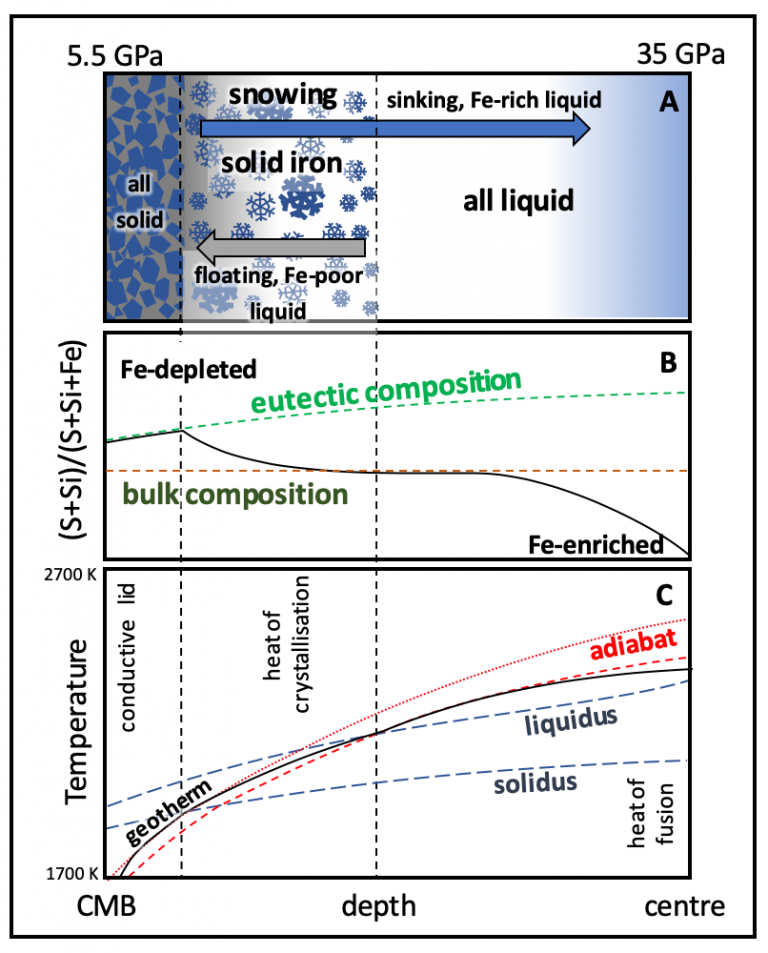The Top-Down Crystallisation of Mercury’s Core
28 October 2019
What is going on inside the planet Mercury? As an enigmatic end-member of the Solar system, Mercury retains many mysteries as to the cause of its high density and most notably to the origin of its magnetic field.

The new paper, “The Top-Down Crystallisation of Mercury’s Core" tackles these questions by studying the materials that form Mercury’s core. To explain its high density, the planet Mercury likely contains a high proportion of iron, however iron alone cannot explain the presence of its magnetic field, as a pure iron core would have solidified by the present day. Here, we look at the properties of an iron alloy, iron-sulphur-silicon, whose behaviour under pressure can reveal how Mercury’s core has evolved over time, and answer the question: has Mercury’s core followed a similar path to our Earth, in which the core crystallises out from the centre, or has a different process governed the growth of the large core of Mercury?
In this paper authors used first principles simulations to calculate the adiabatic gradient of Fe-S-Si. The adiabatic gradient is an important relationship that describes how the temperature changes with pressure, which, when compared with the melting curve of the same material, reveals whether the material will begin to crystallise at the top of the core or at depth within the planet. The results suggest that the core crystallisation of Mercury is very different to that of the Earth, and will instead begin to solidify from the “top-down”, creating solid iron snow that forms at the top of the core and sinks to deeper depths. “Top-down” crystallisation may result in a solid stratified layer at the top of the core which has important implications for the origin, strength and generation of Mercury’s magnetic field.
Lead author, Amy Edgington completed her PhD in the Mineral Physics group in the UCL Earth Sciences department in 2016 working with Lidunka Vocadlo, Lars Stixrude, Ian Wood, David Dobson and Eero Holmstrom. Amy is now the new Outreach Leader for the GeoBus project.
Figure Caption:
Schematic describing the evolution of a hypothetical Fe-S-Si core in the planet Mercury and the consequences of a top-down scenario for the inner core composition, temperature, growth and dynamics. The range of pressure indicated is based on interior models of Mercury (Hauck et al., 2013). The range of temperature indicated is based on estimates of the temperature at the core-mantle boundary (Hauck et al., 2013) and integration of our adiabatic gradient for Fe-S-Si.
Figure A describes the dynamics and processes in the core in which the light-element-enriched material is shown in grey and iron-rich material represented in blue. Iron crystallisation causes segregation of light-element-enriched liquid to the top of the core (approaching the eutectic composition) and sinking of iron-rich solid. This iron then re-melts at depth to produce an iron-enriched deep core, as depicted in Figure B. Crystallisation also releases latent heat of fusion, tilting the shallow geotherm away from the deep adiabat resulting in stable thermal as well as chemical gradients (Figure C). Eventually the solidus is reached in the uppermost core and an entirely solid outermost core grows at the eutectic composition.
Figure B shows the composition field of the core with an iron-depleted upper region and iron enriched lower region due to crystallisation and sinking of iron.
Figure C depicts the temperature field of the core, with two adiabats extrapolated from the temperature at the solidus and liquidus and the modified geotherm which results from shallow freezing and deep re-melting of iron. Vertical dashed lines mark the depths where the geotherm crosses the solidus and liquidus. The deep core might eventually become sufficiently enriched in iron, for the iron-enriched liquidus to cross the geotherm, at which point a deep solid iron inner core will also start to grow. Interpolating between melting curves for pure Fe, Fe74S19Si7 and FeSi (Sakairi et al., 2017; Anzellini et al., 2013; Morard et al., 2018) we estimate that the melting curve for our composition would cross Mercury’s adiabat at around 8 GPa.
Links:
- The top-down crystallisation of Mercury's core. A.L.Edgington, L.Vočadlo, L.Stixrude, I.G.Wood, D.P.Dobson E.Holmström. Earth and Planetary Science Letters. 2019. vol. 528.
- Mineral Physics Group
 Close
Close

